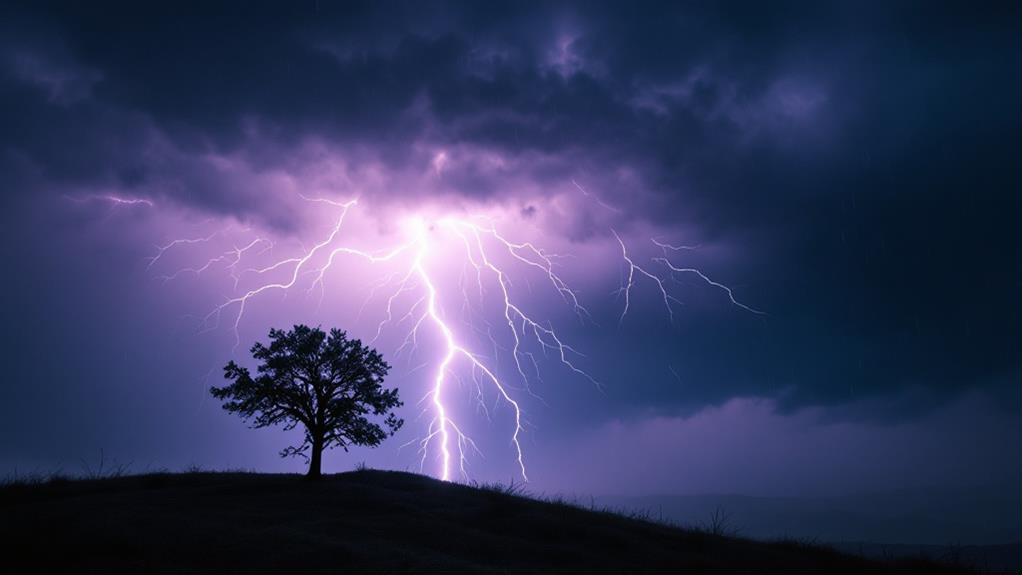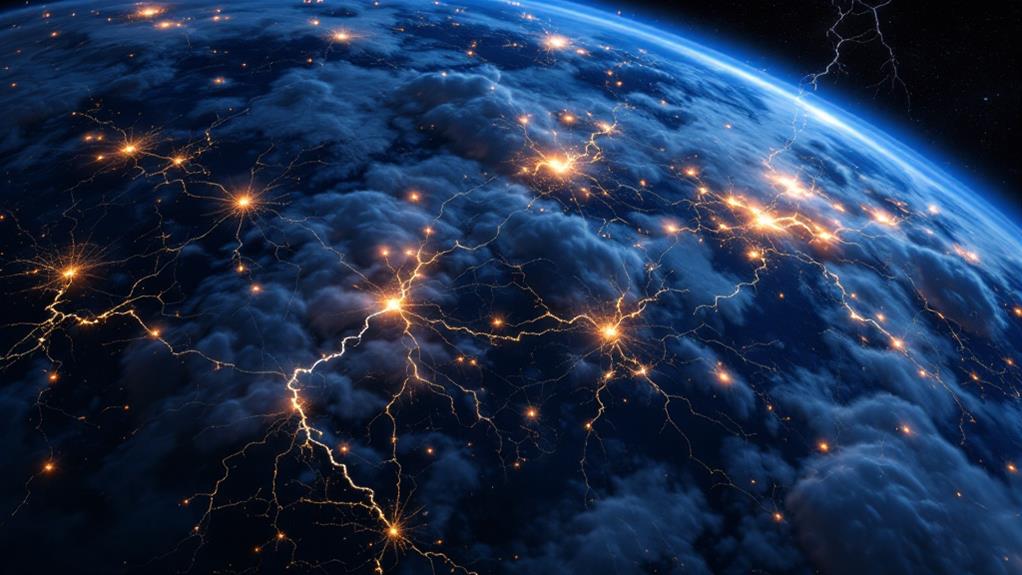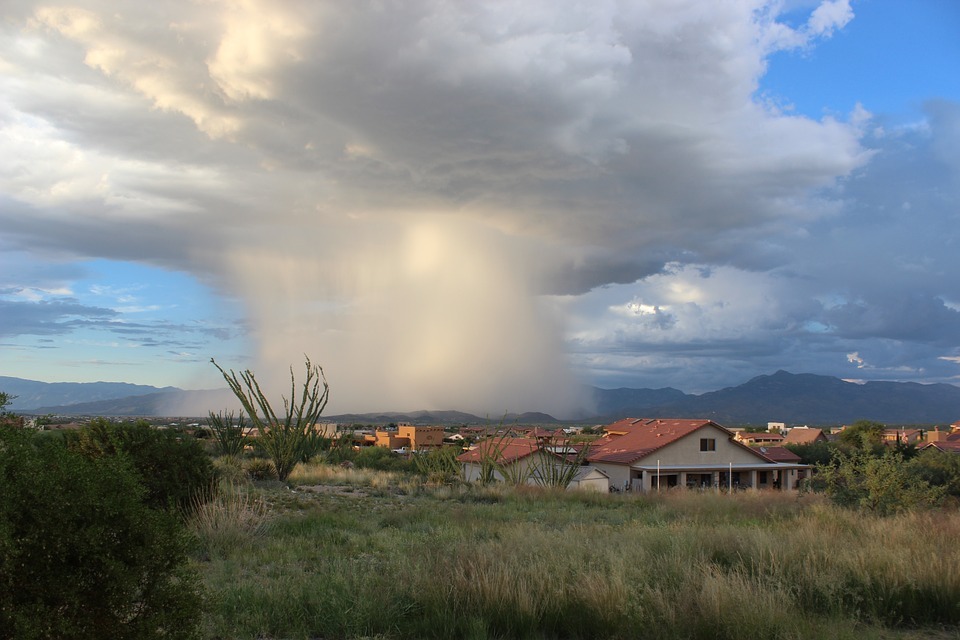What Causes Lightning?

Lightning occurs when electrical charges build up within clouds due to collisions between water droplets, ice crystals, and particles. As lighter positive charges rise and heavier negative charges sink, a significant electrical potential difference develops. This charge separation creates an electric field between the cloud and the ground. When the buildup becomes intense enough, it triggers a rapid discharge of electricity, which you see as a lightning strike. Various types of lightning can occur, including cloud-to-ground, intra-cloud, and cloud-to-cloud. Understanding the atmospheric conditions and detection methods can help you better appreciate this powerful natural phenomenon.
The Basics of Cloud Electricity
Clouds crackle with electrical energy, setting the stage for lightning's dramatic display. As you observe a thunderstorm, you're witnessing a complex process of charge separation within the cloud. This phenomenon occurs when water droplets, ice crystals, and other particles collide and interact. Condensation nuclei like dust and pollen play an essential role in this process, providing surfaces for water vapor to condense and form cloud droplets.
During these collisions, electrons are stripped from some particles and transferred to others. Lighter particles with a positive charge are carried upward by air currents, while heavier, negatively charged particles sink to the cloud's bottom. This vertical movement creates distinct regions of positive and negative charges within the cloud.
As the charge separation continues, a significant electrical potential difference develops between these regions. This charge buildup intensifies until it reaches a critical point. The air, which normally acts as an insulator, can no longer contain the growing electrical tension.
When the electrical field becomes strong enough to overcome the air's resistance, it creates a conductive path. This path allows the rapid discharge of electricity, which you see as lightning. Understanding this basic process of cloud electricity helps explain why thunderstorms are such powerful generators of lightning.
Lightning Formation Process
With the electrical stage set within the cloud, let's examine how lightning actually forms. The process begins with rapid air temperature changes within the cloud. As warm air rises and cool air descends, it creates turbulence that separates electrical charges. This separation leads to an electrical charge buildup, with negative charges gathering at the cloud's base and positive charges at the top.
As the charge difference intensifies, it creates an electric field between the cloud and the ground. When this field becomes strong enough, it ionizes the air, creating a conductive path called a stepped leader. This leader moves downward in a series of short, branching steps.
As the stepped leader nears the ground, it induces an opposite charge. This causes upward-moving streamers to reach out from the ground or tall objects. When a streamer connects with the stepped leader, it completes the circuit. This connection triggers a massive electrical discharge – the bright flash you see as lightning. The return stroke, traveling at about 60,000 miles per second, is what creates the visible bolt from ground to cloud.
Types of Lightning Strikes

Lightning strikes come in several distinct forms, each with unique characteristics and behaviors. The most common type you'll encounter is cloud-to-ground lightning, which occurs when charge separation within a thundercloud results in a negatively charged lower portion. This charge induces a positive charge on the ground below, leading to the formation of upward streamers from tall objects or terrain features.
You might also witness intra-cloud lightning, which flashes within a single cloud, or cloud-to-cloud lightning, jumping between separate clouds. These types don't pose as much direct danger to people on the ground but can still be impressive displays.
Less frequent but equally fascinating are ground-to-cloud lightning strikes, where the upward streamers initiate the discharge. You'll typically see these originating from tall structures like skyscrapers or communication towers.
Lastly, there's ball lightning, a rare and mysterious phenomenon where glowing, spherical objects appear during thunderstorms. Scientists are still studying this type to fully understand its properties and formation.
Each lightning type contributes to the complex and awe-inspiring electrical displays you witness during storms, showcasing nature's raw power.
Atmospheric Conditions for Lightning
Thunderstorms brew the perfect conditions for lightning to strike. These powerful storms create an environment where cloud charge distribution becomes increasingly uneven. As warm air rises rapidly within the storm, it carries water vapor and tiny ice crystals upward. These particles collide and separate, leading to thunderstorm electrification.
You'll find that the upper portions of storm clouds typically develop a positive charge, while the lower regions become negatively charged. This charge separation is indispensable for lightning formation. As the electrical potential difference between these areas grows, it sets the stage for dramatic discharges.
The atmosphere's composition also plays a role. Dry air beneath the storm cloud can act as an insulator, allowing the charge buildup to continue until it reaches a critical point. When the electric field becomes strong enough, it ionizes the air, creating a conductive path for the lightning strike.
Wind patterns and temperature variations within the storm further contribute to the complex atmospheric conditions necessary for lightning. Understanding these factors helps meteorologists predict when and where lightning is most likely to occur, improving safety measures and storm forecasting capabilities.
Lightning Detection and Prediction

In light of the complex atmospheric conditions that generate lightning, scientists have developed sophisticated methods for its detection and prediction. You'll find that modern lightning sensor technology has revolutionized our ability to track and forecast these powerful electrical discharges. These sensors use various techniques, including radio frequency detection and optical sensing, to pinpoint lightning strikes with extraordinary accuracy. Lightning can heat the air to 50,000°F, causing severe burns and injuries, so this technology is essential for public safety.
Lightning prediction models have also become increasingly advanced, incorporating real-time data from weather stations, satellites, and radar systems. These models analyze atmospheric conditions, such as temperature, humidity, and wind patterns, to forecast the likelihood of lightning activity in specific areas.
- Ground-based lightning sensor networks
- Satellite-based lightning detection systems
- Advanced weather radar technology
- Machine learning algorithms for improved forecasting
Frequently Asked Questions
Can Lightning Strike the Same Place Twice?
Yes, lightning can strike the same place twice, and it often does. You might be surprised to learn that tall structures and landmarks are frequently hit multiple times. Lightning detection systems have shown that some locations are more prone to strikes due to their height or geographic features. That's why you'll often see lightning rod installations on skyscrapers and other tall buildings. These rods help protect structures by safely channeling lightning's energy into the ground, reducing the risk of damage from repeated strikes.
How Hot Is a Lightning Bolt?
You might be surprised to learn just how hot a lightning bolt can get. When it strikes, a lightning bolt reaches extremely high temperatures, hotter than the surface of the sun! We're talking about 50,000 degrees Fahrenheit or more. That's five times hotter than the sun's surface! But don't worry, it cools down quickly. The rapid cooling process happens in milliseconds, preventing widespread damage. It's nature's spectacular light show with an incredible heat factor.
What Is the Difference Between Lightning and Thunder?
You'll notice lightning and thunder are closely related but distinct phenomena. Lightning is the visible flash you see, caused by electrical charge buildup in the atmosphere. It's a massive spark that travels between clouds or from clouds to the ground. Thunder, on the other hand, is the sound you hear after lightning strikes. It's created by the rapid heating and expansion of air around the lightning bolt. Atmospheric conditions influence both lightning and thunder intensity.
Is It Safe to Use Electronic Devices During a Thunderstorm?
During a thunderstorm, it's best to avoid using electronics for your safety. You should unplug devices to protect them from potential power surges. Lightning can travel through electrical systems, putting you at risk if you're using connected devices. While the chances of being struck are low, it's better to err on the side of caution. Stick to battery-powered devices if necessary, and wait until the storm passes before resuming normal electronic use.
How Far Away Can Lightning Travel From Its Original Storm?
You might be surprised by how far lightning can travel! The lightning strike range can extend up to 10 miles from its original storm. As the lightning storm movement progresses, it can create what's called "bolt from the blue" strikes. These occur when lightning travels horizontally and then strikes the ground far from the storm's center. So, even if you're not directly under a thunderstorm, you should still be cautious and seek shelter when you hear thunder.




